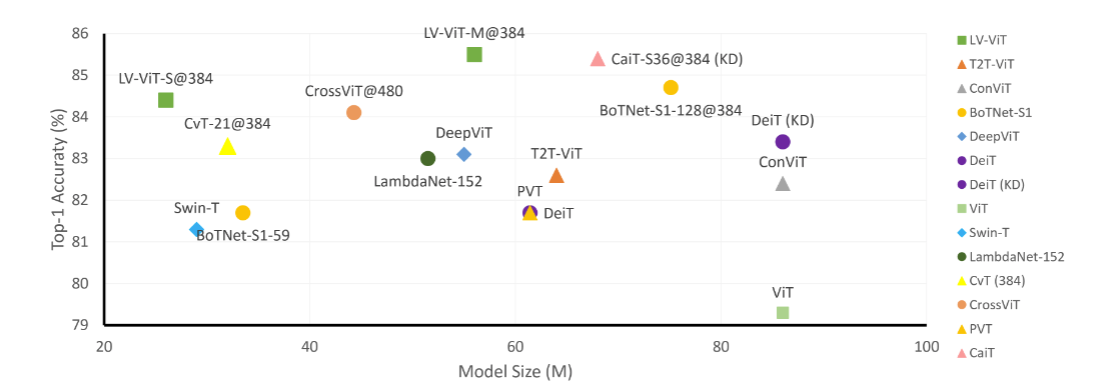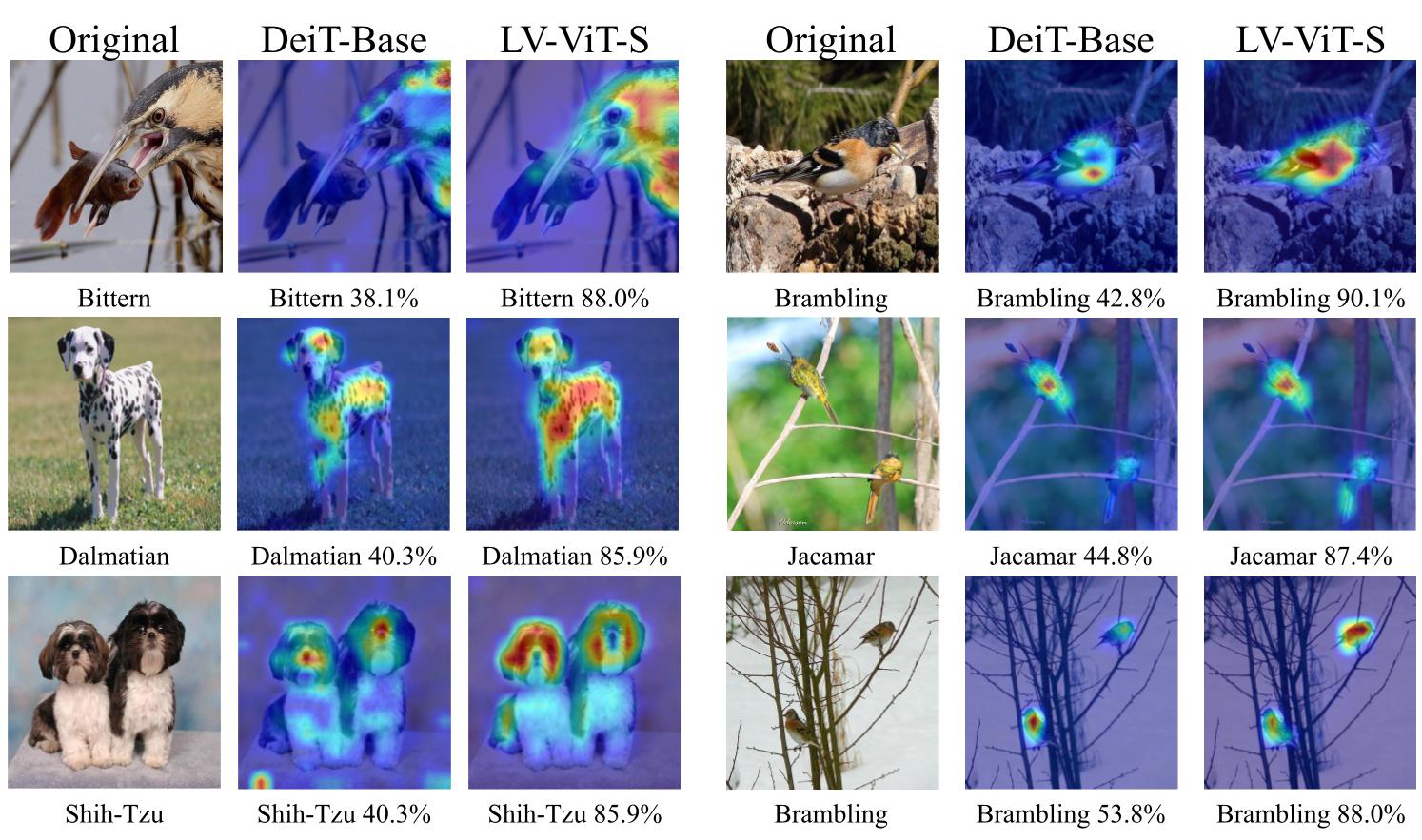All Tokens Matter: Token Labeling for Training Better Vision Transformers (arxiv)
This is a Pytorch implementation of our paper.
Comparison between the proposed LV-ViT and other recent works based on transformers. Note that we only show models whose model sizes are under 100M.
Our codes are based on the pytorch-image-models by Ross Wightman.
2021.7: Add script to generate label data.
2021.6: Support pip install tlt to use our Token Labeling Toolbox for image models.
2021.6: Release training code and segmentation model.
2021.4: Release LV-ViT models.
| Model | layer | dim | Image resolution | Param | Top 1 | Download |
|---|---|---|---|---|---|---|
| LV-ViT-T | 12 | 240 | 224 | 8.53M | 79.1 | link |
| LV-ViT-S | 16 | 384 | 224 | 26.15M | 83.3 | link |
| LV-ViT-S | 16 | 384 | 384 | 26.30M | 84.4 | link |
| LV-ViT-M | 20 | 512 | 224 | 55.83M | 84.0 | link |
| LV-ViT-M | 20 | 512 | 384 | 56.03M | 85.4 | link |
| LV-ViT-M | 20 | 512 | 448 | 56.13M | 85.5 | link |
| LV-ViT-L | 24 | 768 | 448 | 150.47M | 86.2 | link |
| LV-ViT-L | 24 | 768 | 512 | 150.66M | 86.4 | link |
torch>=1.4.0 torchvision>=0.5.0 pyyaml scipy timm==0.4.5
data prepare: ImageNet with the following folder structure, you can extract imagenet by this script.
│imagenet/
├──train/
│ ├── n01440764
│ │ ├── n01440764_10026.JPEG
│ │ ├── n01440764_10027.JPEG
│ │ ├── ......
│ ├── ......
├──val/
│ ├── n01440764
│ │ ├── ILSVRC2012_val_00000293.JPEG
│ │ ├── ILSVRC2012_val_00002138.JPEG
│ │ ├── ......
│ ├── ......
Replace DATA_DIR with your imagenet validation set path and MODEL_DIR with the checkpoint path
CUDA_VISIBLE_DEVICES=0 bash eval.sh /path/to/imagenet/val /path/to/checkpoint
We provide NFNet-F6 generated dense label map in Google Drive and BaiDu Yun (password: y6j2). As NFNet-F6 are based on pure ImageNet data, no extra training data is involved.
Train the LV-ViT-S:
If only 4 GPUs are available,
CUDA_VISIBLE_DEVICES=0,1,2,3 ./distributed_train.sh 4 /path/to/imagenet --model lvvit_s -b 256 --apex-amp --img-size 224 --drop-path 0.1 --token-label --token-label-data /path/to/label_data --token-label-size 14 --model-ema
If 8 GPUs are available:
CUDA_VISIBLE_DEVICES=0,1,2,3,4,5,6,7 ./distributed_train.sh 8 /path/to/imagenet --model lvvit_s -b 128 --apex-amp --img-size 224 --drop-path 0.1 --token-label --token-label-data /path/to/label_data --token-label-size 14 --model-ema
Train the LV-ViT-M and LV-ViT-L (run on 8 GPUs):
CUDA_VISIBLE_DEVICES=0,1,2,3,4,5,6,7 ./distributed_train.sh 8 /path/to/imagenet --model lvvit_m -b 128 --apex-amp --img-size 224 --drop-path 0.2 --token-label --token-label-data /path/to/label_data --token-label-size 14 --model-ema
CUDA_VISIBLE_DEVICES=0,1,2,3,4,5,6,7 ./distributed_train.sh 8 /path/to/imagenet --model lvvit_l -b 128 --lr 1.e-3 --aa rand-n3-m9-mstd0.5-inc1 --apex-amp --img-size 224 --drop-path 0.3 --token-label --token-label-data /path/to/label_data --token-label-size 14 --model-ema
If you want to train our LV-ViT on images with 384x384 resolution, please use --img-size 384 --token-label-size 24.
To Fine-tune the pre-trained LV-ViT-S on images with 384x384 resolution:
CUDA_VISIBLE_DEVICES=0,1,2,3,4,5,6,7 ./distributed_train.sh 8 /path/to/imagenet --model lvvit_s -b 64 --apex-amp --img-size 384 --drop-path 0.1 --token-label --token-label-data /path/to/label_data --token-label-size 24 --lr 5.e-6 --min-lr 5.e-6 --weight-decay 1.e-8 --finetune /path/to/checkpoint
To Fine-tune the pre-trained LV-ViT-S on other datasets without token labeling:
CUDA_VISIBLE_DEVICES=0,1,2,3,4,5,6,7 ./distributed_train.sh 8 /path/to/dataset --model lvvit_s -b 64 --apex-amp --img-size 224 --drop-path 0.1 --token-label --token-label-size 14 --dense-weight 0.0 --num-classes $NUM_CLASSES --finetune /path/to/checkpoint
Our Segmentation model are fully based upon the MMSegmentation Toolkit. The model and config files are under seg/ folder which follow the same folder structure. You can simply drop in these file to get start.
git clone https://github.com/open-mmlab/mmsegmentation # and install
cp seg/mmseg/models/backbones/vit.py mmsegmentation/mmseg/models/backbones/
cp -r seg/configs/lvvit mmsegmentation/configs/
# test upernet+lvvit_s (add --aug-test to test on multi scale)
cd mmsegmentation
./tools/dist_test.sh configs/lvvit/upernet_lvvit_s_512x512_160k_ade20k.py /path/to/checkpoint 8 --eval mIoU [--aug-test]| Backbone | Method | Crop size | Lr Schd | mIoU | mIoU(ms) | Pixel Acc. | Param | Download |
|---|---|---|---|---|---|---|---|---|
| LV-ViT-S | UperNet | 512x512 | 160k | 47.9 | 48.6 | 83.1 | 44M | link |
| LV-ViT-M | UperNet | 512x512 | 160k | 49.4 | 50.6 | 83.5 | 77M | link |
| LV-ViT-L | UperNet | 512x512 | 160k | 50.9 | 51.8 | 84.1 | 209M | link |
We apply the visualization method in this repo to visualize the parts of the image that led to a certain classification for DeiT-Base and our LV-ViT-S. The parts of the image that used by the network to make the decision are highlighted in red.
To generate token label data for training:
python3 generate_label.py /path/to/imagenet/train /path/to/save/label_top5_train_nfnet --model dm_nfnet_f6 --pretrained --img-size 576 -b 32 --crop-pct 1.0If you use this repo or find it useful, please consider citing:
@inproceedings{NEURIPS2021_9a49a25d,
author = {Jiang, Zi-Hang and Hou, Qibin and Yuan, Li and Zhou, Daquan and Shi, Yujun and Jin, Xiaojie and Wang, Anran and Feng, Jiashi},
booktitle = {Advances in Neural Information Processing Systems},
editor = {M. Ranzato and A. Beygelzimer and Y. Dauphin and P.S. Liang and J. Wortman Vaughan},
pages = {18590--18602},
publisher = {Curran Associates, Inc.},
title = {All Tokens Matter: Token Labeling for Training Better Vision Transformers},
url = {https://proceedings.neurips.cc/paper/2021/file/9a49a25d845a483fae4be7e341368e36-Paper.pdf},
volume = {34},
year = {2021}
}
T2T-ViT, Re-labeling ImageNet, MMSegmentation, Transformer Explainability.

